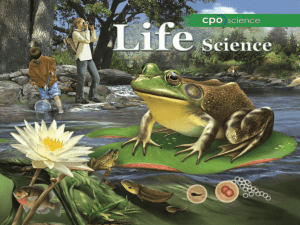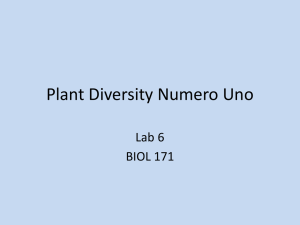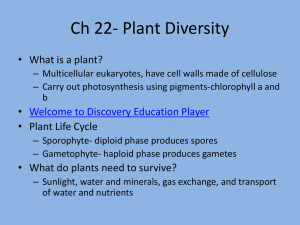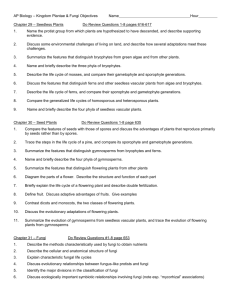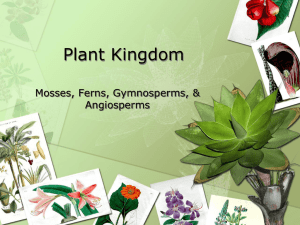Plant
advertisement
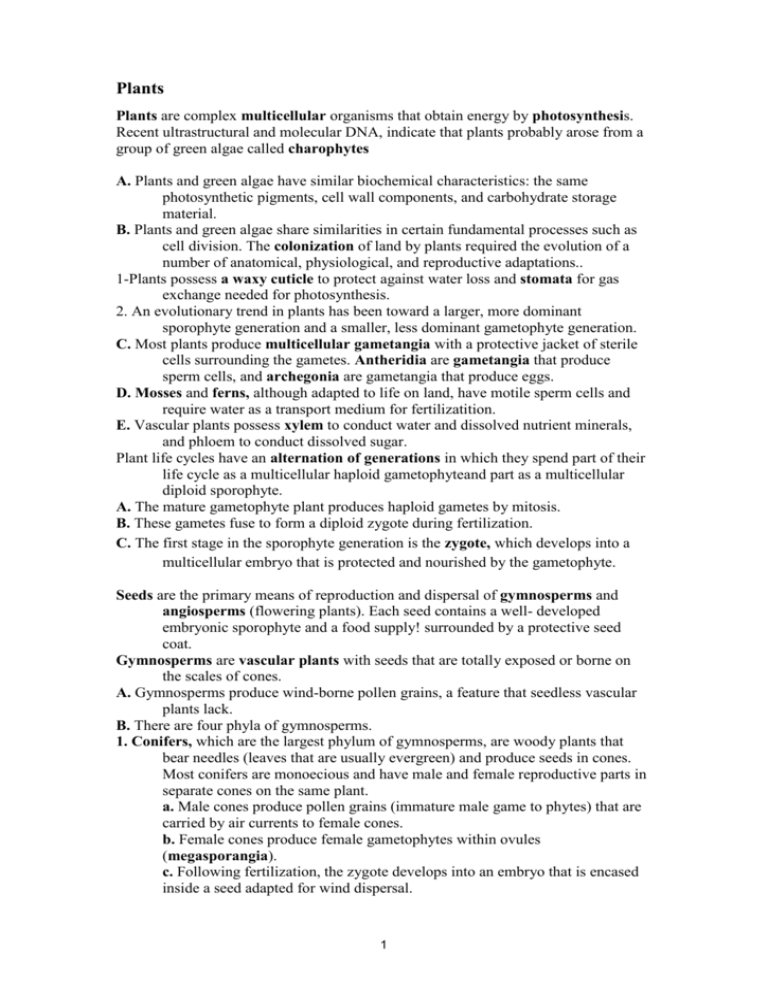
Plants Plants are complex multicellular organisms that obtain energy by photosynthesis. Recent ultrastructural and molecular DNA, indicate that plants probably arose from a group of green algae called charophytes A. Plants and green algae have similar biochemical characteristics: the same photosynthetic pigments, cell wall components, and carbohydrate storage material. B. Plants and green algae share similarities in certain fundamental processes such as cell division. The colonization of land by plants required the evolution of a number of anatomical, physiological, and reproductive adaptations.. 1-Plants possess a waxy cuticle to protect against water loss and stomata for gas exchange needed for photosynthesis. 2. An evolutionary trend in plants has been toward a larger, more dominant sporophyte generation and a smaller, less dominant gametophyte generation. C. Most plants produce multicellular gametangia with a protective jacket of sterile cells surrounding the gametes. Antheridia are gametangia that produce sperm cells, and archegonia are gametangia that produce eggs. D. Mosses and ferns, although adapted to life on land, have motile sperm cells and require water as a transport medium for fertilizatition. E. Vascular plants possess xylem to conduct water and dissolved nutrient minerals, and phloem to conduct dissolved sugar. Plant life cycles have an alternation of generations in which they spend part of their life cycle as a multicellular haploid gametophyteand part as a multicellular diploid sporophyte. A. The mature gametophyte plant produces haploid gametes by mitosis. B. These gametes fuse to form a diploid zygote during fertilization. C. The first stage in the sporophyte generation is the zygote, which develops into a multicellular embryo that is protected and nourished by the gametophyte. Seeds are the primary means of reproduction and dispersal of gymnosperms and angiosperms (flowering plants). Each seed contains a well- developed embryonic sporophyte and a food supply! surrounded by a protective seed coat. Gymnosperms are vascular plants with seeds that are totally exposed or borne on the scales of cones. A. Gymnosperms produce wind-borne pollen grains, a feature that seedless vascular plants lack. B. There are four phyla of gymnosperms. 1. Conifers, which are the largest phylum of gymnosperms, are woody plants that bear needles (leaves that are usually evergreen) and produce seeds in cones. Most conifers are monoecious and have male and female reproductive parts in separate cones on the same plant. a. Male cones produce pollen grains (immature male game to phytes) that are carried by air currents to female cones. b. Female cones produce female gametophytes within ovules (megasporangia). c. Following fertilization, the zygote develops into an embryo that is encased inside a seed adapted for wind dispersal. 1 2. Cycads are palmlike or fernlike in appearance. They are dioecious that is, they have male and female reproductive structures on separate plants but reproduce with pollen and seeds in cone-like structures. There are relatively few living members of this once large phylum.Ginkgo biloba, the only surviving species in its phylum, is a deciduous, dioecious tree. The female ginkgo produces fleshy seeds directly on branches. 3. Gnetophytes share a number of traits with angiosperms, such as efficient water conductingceils (vessel elements) in their xylem. Flowering plants (angiosperms) constitute the phylum of vascular plants that produce seeds enclosed within a fruit. They are the most diverse and most successful group of plants. A. Flowering plants have several specialized features that account for their success. 1. The flower, which may contain sepals, petals, stamens, and carpels, functions in sexual reproduction. 2. Double fertilization, which results in the foffilation of adiploidzygote and triploid endosperm, is characteristic of flowering plant. 3. Unlike those of gymnospeffils, the ovules of flowering plants are enclosed within an ovary. After fertilization, the ovules become seeds, and the ovary develops into a fruit. 4. Flowering plants possess efficient water-conducting cells, called vessel elements, in their xylem and efficient carbohydrate conduction cells, called sieve tube members, in their phloem. 5. Wind, water, insects, or other animals transfer pollen grains in various flowering plants. There are two classes of flowering plants. 1. Most monocots have floral parts in multiples of three, and their seeds each contain one coryledon. The nutritive tissue in their mature seeds is endosperm. 2. Dicots usually have floral parts in multiples of four or five, and their seeds each contain two coryledons. The nutritive organs in their mature seeds are usually the cotyledons, which have ab- sorbed the nutrients in the endosperm. N. Seed plants arose-from seedless vascular plants. A. Progymnosperms were seedless vascular plants that had megaphylls and "modem" woody tissue. Archaeopteris is a representative progymnosperm. 1. Progymnosperms probably gave rise to conifers. 2. Progymnosperms probably gave rise to seed ferns as well, which in turn probably gave rise to cycads and possibly ginkgo. B. The evolution of the gnetophytes, particularly their relationship flowering plants, is unclear. C. Flowering plants probably descended from ancient gymnospeffils that had specialized features, such as leaves with broad, expanded blades and closed carpels. 1. Flowering plants probably arose only once, 2. The first flowering plants were probably dicots that were weedy shrubs or small herbaceous plants. Amborellais a dicot that may be the nearest living relative to the ancestor of all flowering plants. D. The mature sporophyte plant produces sporogenous cells (spore mother cells). These undergo meiosis to form haploid spores, which are the first stage in the gametophyte generation. 2 4. Mosses and other bryophytes have several adaptations that green algae lack, including a cuticle, stomata, and multicellular gametangia. They are nonvascular (lacking xylem and phloem). 5. Bryophytes are the only plants with a dominant gametophyte generation. Their sporophytes remain permanently attached and nutritionally dependent on the gametophyte. 1.Moss gametophytes are green plants that grow from a filamentous protonema. 2. Liverwort gametophytes are either leafy or thalloid. 3. Hornworts have thalloid gametophytes. Fossil evidence of ancient plants and structural and molecular evidence of living plants are used to infer bryophyte evolution. A. The bryophytes may be the first group of plants to arise from the common plant ancestor. B. Molecular evidence supports the hypothesis that hornworts may be the most ancient group of plants alive today. Two types of leaves evolved in the plant kingdom. 1. Microphylls, small leaves thought to have evolved from lateral projections of stem tissue, are characteristic of club mosses. 2. Megaphylls, leaves that probably evolved from branch systems, are characteristic of all vascular plants other than whisk ferns, which lack leaves, and club mosses. 3. Ferns and fern allies have several adaptations that algae and bryophytes lack, including vascular tissues and a dominant sporophyte generation. 4. Ferns are the largest and most diverse group of seedless vascular plants. A. Fern sporophytes have roots, rhizomes, and leaves that are megaphylls. Their leaves, called fronds, bear sporangia in clusters called sari. Meiosis in sporangia produces haploid spores. B. The fern gametophyte, called a prothallus, develops from a haploid spore and bears both archegonia and antheridia. C. Reproduction in ferns depends on water as a transport medium for their motile sperm cells. D. Sporophytes of whisk ferns consist of dichotomously branching rhizomes and erect sterns; they lack true roots and leaves. Psilotum is a representative whisk fern. Horsetail sporophytes have roots, rhizomes, aerial stems that are hollow and jointed, and leaves that are reduced megaphylls. Equise turn is a representative horsetail. E. Sporophytes of club mosses consist of roots, rhizomes, erect branches, and leaves that are microphylls. Lycopodium and Selagmella are representative club mosses. 5. Vascular plants are either homosporous or heterosporous. A. Homospory, the production of one kind of spore, is characteristic of bryophytes, whisk ferns, horsetails, most club mosses, and most ferns. B. Heterospory, the production of two kinds of spores (microspores and megaspores), occurs in certain club mosses and ferns and in all seed plants. The evolution of heterospory was an essential step in the evolution of seeds. 3 1. Microspores give rise to male gametophytes that produce sperm cells. 2. Megaspores give rise to female gametophytes that produce eggs. 6. The fossil record indicates that several lines of vascular plants had evolved by the mid-Silurian period, about 420 mya. A. Rhynia gwYTllle-lJaughannii is an example of one of the earliest vascular plants. It superficially resembles whisk ferns. B. The ferns and fern allies were Earth's dominant plants in past ages. C. Coal formed largely from the prehistoric remains of ancient ferns, club mosses, and horsetails. These plants existed during the Carboniferous period, approximately 300 mya. 4




